Land Invertebrates
Media
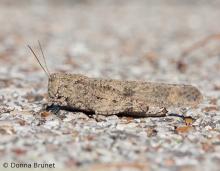
Species Types
Scientific Name
Dissosteira carolina
Description
The Carolina grasshopper is frequently seen in dusty, open habitats like dirt roads and vacant lots. Its yellow-bordered, black hindwings make it look like a mourning cloak butterfly.
Media
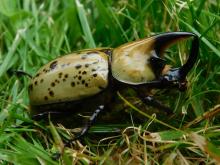
Species Types
Scientific Name
Dynastes tityus
Description
The eastern Hercules beetle is a breathtaking animal. Like its Greek-hero namesake, it is big and strong. Males have horns; females do not. Hercules beetles are harmless to people.
Media
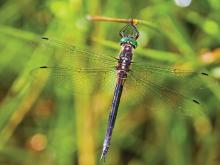
Species Types
Scientific Name
Somatochlora hineana
Description
The Hine's emerald dragonfly is a federally endangered species. It has a dark emerald-green thorax and two yellow stripes on its sides. It lives in calcareous spring-fed marshes and sedge meadows overlaying dolomite bedrock.
Media
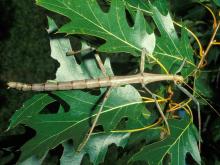
Species Types
Scientific Name
Megaphasma denticrus
Description
The giant walkingstick is the largest insect in North America, with females up to 7 inches long. The middle and hind legs have spines. Males have a single, large spine on each hind leg.
Media

Species Types
Scientific Name
Diapheromera femorata
Description
The northern walkingstick is Missouri's most common species of walkingstick. It is perfectly camouflaged for a life in trees and shrubs. They not only look like twigs but also sway their bodies to mimic the motion of branches in a breeze.
Media
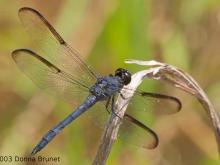
Species Types
Scientific Name
Libellula incesta
Description
The slaty skimmer has a body about 2 inches long. Older males are all slate blue with black heads. Young males and females have brown abdomens and a dark stripe running down the back.
Media

Species Types
Scientific Name
Schistocerca spp.
Description
About six species of bird grasshoppers occur in Missouri. Most are attractively marked, large insects that gracefully fly from danger, almost like birds.
Media
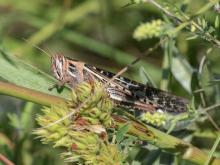
Species Types
Scientific Name
Schistocerca americana
Description
The American bird grasshopper is a large grasshopper with ornate markings. It is a good flier that floats upward into trees. Note the pale stripe running down the back.
Media

Species Types
Scientific Name
About 175 species in North America
Description
Earthworms are familiar to just about everyone who digs in the soil. They play a major role in the nutrient cycling and structure of soils. There are many species. The most familiar ones in Missouri are nonnative.
Media
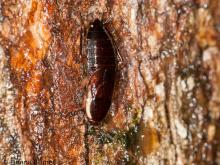
Species Types
Scientific Name
Over 100 species of cockroaches and termites in North America north of Mexico
Description
Cockroaches well-known: they are flattened, small, brown or black, often shiny insects that can hide in tight crevices and lack specialized appendages. Recently, termites have been included in their order.
See Also



Media

Species Types
Scientific Name
Cisseps fulvicollis
Description
The yellow-collared scape moth is more often “orange-collared.” And whether you think it looks more like a firefly or a wasp, it’s still a moth!
Media

Species Types
Scientific Name
Nearly 150 species in North America north of Mexico
Description
Slim, delicate plume moths are instantly recognizable by their T-shaped silhouette, long legs, and muted shades of tan and brown. It can be hard to separate the various species.
Media

Species Types
Scientific Name
Pyrrharctia isabella
Description
Not many people know the adult Isabella tiger moth when they see one, but we’re all acquainted with its caterpillar, the woolly worm, or woolly bear.
About Land Invertebrates in Missouri
Invertebrates are animals without backbones, including earthworms, slugs, snails, and arthropods. Arthropods—invertebrates with “jointed legs” — are a group of invertebrates that includes crayfish, shrimp, millipedes, centipedes, mites, spiders, and insects. There may be as many as 10 million species of insects alive on earth today, and they probably constitute more than 90 percent all animal species.





















